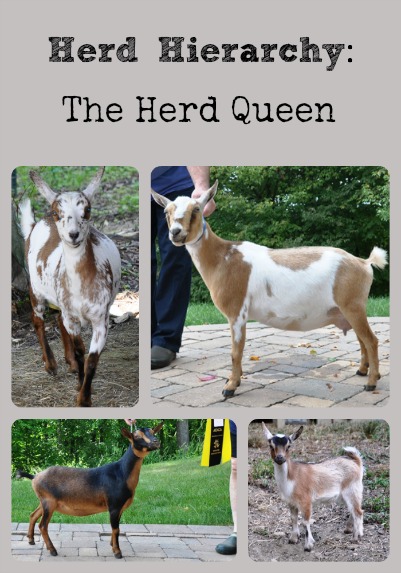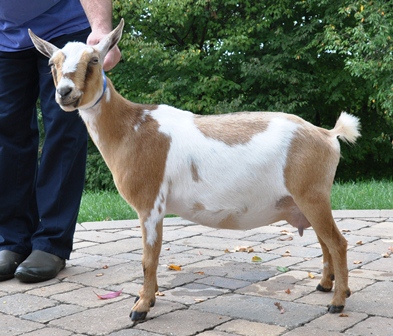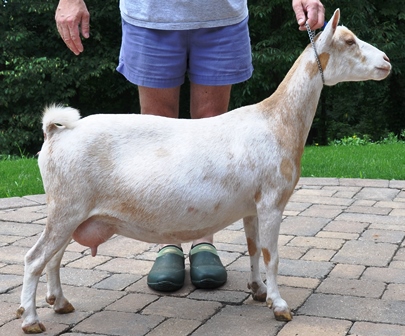Every goat-herd has a defined social hierarchy (pecking order), and the number one female goat 
The goats establish their hierarchy through rearing and head butting or just butting, and it can be a little disturbing to watch as they sort out their social positions. However, by understanding that it’s normal behavior and what they’re trying to accomplish, we can learn a lot about our herd dynamics and make better management decisions.
The herd queen tends to be the most aggressive, oldest, and largest (also horned if there are horned goats) goat in the herd, but that can vary depending on herd makeup. She’s the goat that will lead the herd out to pasture and determine where they should browse, and in wild herds, is responsible for teaching the herd which plants are poisonous or inedible. If she finds a plant that’s poisonous, she’ll sniff it, snort at it, and display her dislike of the plant. The rest of the herd will then sniff the plant thereby learning which plants to avoid.


In our herd, the queen isn’t the largest, oldest, or best milk producer (that’s her in the picture on the left vs. our largest doe on the right), but she’s certainly the most active. She’s also doesn’t seem that affectionate and is very stubborn, so she’s not my favorite doe. Understanding that she’s the herd queen, and that her agenda is a little different, at least helps me appreciate her even when she’s being her most stubborn.
Aja Nichols says
Hi Lesa!
I have two mixed does about 8 months old and now a Nigerian Dwarf buckling (Nemo)at about 3 months old who is slightly underdeveloped from birth. (one ear shorter than other and floppy, never had mom and mom rejected him) my herd queen(Mistletoe) is way too aggressive with him, but my other doe (Gadget) loves to play with him. If I segregate the herd queen for a period of time and let Gadget and Nemo bond, will my herd queen be less aggressive toward him eventually? I’m new to goats, and her behavior is really upsetting me because I worked hard to keep Nemo alive.
PJ says
I wish Lesa had replied to this question. I am in almost the same situation.
Lesa says
Hi Aja, I just came across your comment – sorry I missed it for so long! Also, I’m not sure of the answer to your question – we don’t let the bucks mingle with the does because even a young buck like Nemo can start breeding the does and we always wanted to know exactly when the kids were going to come along. So, we only put bucks and does together the day a doe was in heat so we would know exactly when she would be kidding. What happened in your herd with Nemo, Mistletoe and Gadget?
Aja Nichols says
Well we had to give up Mistletoe because her behavior never ended. We talk to the people who have her still and she kidded in December. Gadget just gave birth 3 weeks ago to Nemo’s kids! Triplets! All bucklings too. Everyone is happier for the decision 😊
Lisa says
Hi
Great reading!!
I have 2 Pygmys & 2 Nubians. My herd queen is one of my Pygmys & the other Pygmy was second in command & the Nubians both below that & got pushed around by both my pygmys. Past few days the lowest Nubian has really been beating on my second in command relentlessly!! My # 2 is now terrified of her!! (The #1 is still # 1)
Why can things change so much in a couple of days?!! I bred my 2 Pygmys in November so I’m worried for my smallest Pygmy 🙁
Cary Lee says
I have a small herd of Boers – 6 does one buck and a young wether. While I was out yesterday one of my does became stuck in a fence and we found her when we returned in the afternoon. She had cried herself hoarse but she soon came good with water and lucerne hay. However, the herd now treats her as an outcast. Two of the does in particular have suddenly become very aggressive towards her, butting her out of the way when I lay out their supplemental feed and not letting her be close to the others. She stands at the edge of the herd, and appears afraid to step in or be too close. The Queen hasn’t particpated in the agression – she’s 10 years old and very sure of herself. One of the does who is most aggressive is likely to be the Lady in Waiting. She was not at the bottom of the pecking order prior to getting caught in the fence, rather it was the wether and one other smaller doe who although smaller are also now butting her. All of the goats are hand tame, and are groomed and patted regularly so I have not paid her any different sort of attention, other than bringing her into a smaller paddock when we first found her to give her water – it was a 40 degree Celsius day. Is there anything I can do to help restore the herd dynamic?
Lesa says
Hi Cary Lee,
I don’t know the answer to your question, it seems odd that they would have so quickly changed dynamics. I’m curious to learn if she regains her former position and how long it takes.
Scott says
We have 3 Pygmy goats. 2 females and 1 fixed male. They have all coexist perfectly for 5 years.
Our smaller female had been our dominant female until about a month ago. Since that time the larger female has become very aggressive. Lots of hard head butts, the smaller goat is definitely keeping her distance all the time. The smaller female now is sleeping out side. We have an overhang so she is out of the elements but still cold and windy.
Is this normal? What is your suggestion?
Thank you, Scott
Amy says
I adopted two goats that have horns. My others do not. The female with horns is doing a lot of head butting with my other herd queen and I can tell it hurts her by the way she shakes her head after. Should I debud the goats for safety?
Lesa says
Hi Amy, Most goat herd owners choose not to mix horned with non-horned goats for safety reasons. I wrote a bit on that here: http://www.betterhensandgardens.com/getting-dairy-goats-disbudded-horned-or-polled/ If the goats are already older, it can be difficult to remove the horns.
Kaeryn Silvera says
Interesting article, as usual! I’ve had NDs for 4 1/2 years now and have had 5 herd queens in that time, as I went from pet to performance quality through trial and error.
Each time a doe has been promoted to herd queen by position vancancy, she has changed from affectionate and docile to unaffectionate and stubborn. That’s a necessary shift, I can see, but I liked reading it here. Interesting that your herd queen isn’t the oldest. I thought the doe with the most freshenings had natural seniority, but obviously it’s partly temperament. This is a really accessible description of the herd queen position. Thank you!
Sherry Smith says
New doe in a group of six does has become “Queen”.. She is an aggressive butter and may have caused one doe to abort her twins. Any way to discourage her or does she need to find a new home?
Lesa says
Hi Sherry, I don’t know of any way to stop a doe that wants to be herd queen from establishing her dominance. Once she does establish dominance, she may become less aggressive, but butting is part of behavior in a goat herd.
Christine says
I have a 2yo Nigerian dwarf female who was herd queen at her last home. Give had her about 3 months and she was very affectionate but lonely. I got two more goats that were baby Nigerian/Spanish crosses and both unaltered males. They seem to be going through puberty and started harassing her and she’s been really sad. One is now a little bigger than her and she no longer headbutts or established her dominance. She wont even come up to me anymore. I thought maybe if I got 2 more females, it would get the fellas attention off of her and it has for the most part, but her attitude hasn’t changed. What should I do?
Lesa says
Christine, You realize she’s probably pregnant, right?
Amy says
We have just added a new doe kid to our farm, and while our herd queen, who I thought would be the issue, is doing great with her, the other dry yearling is pretty aggressive towards her! I couldn’t believe my sweet little Lu Cee was being such a bully! Do you have any suggestions on how to integrate them all together? I’ve actually pulled Lu Cee into solitary for a medical issue currently, and the other two are getting along pretty well. Do you think there will be a bigger problem when she gets out of solitary? Thanks! I really enjoy reading your blog, you have such a wealth of info on here!
Lesa says
Hi Amy, It sounds to me like your herd queen is not afraid of losing her position, but Lu Cee is. Someone always has to be at the bottom of the pecking order, and the goat just above her will usually work to make sure she doesn’t become the bottom goat. If the herd queen and Lu Cee are mother and daughter, then Lu Cee will likely continue as herd princess and continue to “protect” her mother’s position. If they’re not mother and daughter, then it’s likely that when you reintroduce Lu Cee, she and the doe kid will be vying for who’s on top. I’m afraid I don’t have any suggestions on how to integrate them without head-butting, they seem to need to establish the hierarchy, and then defend their position in it. Things do tend to calm down over time. About all you can do is make sure that the goat on the bottom of the pecking order has room to get away, and that there are enough feeding stations so that she gets a chance to eat. Thank you on the blog!
Mel says
Question: we have a mixed herd (1 Alpine – she’s the queen of the castle, 1 mini-Nubian, and 4 Nigerian Dwarfs). They all get along well in their established pecking order except one little Nigerian who was recently added to the herd without a companion (she was bred but miscarried, I think due to stress). The other goats, particularly the Alpine who outweighs her by almost too lbs, are very hard on her and even now, 5 months later, still do not allow her to eat. We have been forced to feed her separately since she has actually been injured by the larger goats. Is there anything we can do except try to find a new home for her? Will the same thing happen when our Nigerians have their babies?
Mel says
typo: Alpine outweighs her by almost *100 pounds
Lesa says
Hi Mel, You might want to think about finding a new home for the Alpine as opposed to the Nigerian. When the Nigerian does have babies, they will likely try to protect their offspring; however, if the Alpine is a bully there may not be much they can do about it.
Audrey says
I love this post. Watching herd dynamics is fascinating.
My herd queen is a homely girl that is very friendly, raises quads unassisted each year and is an all-around great goat. Strangely, her daughters haven’t assumed second position to her. I credit it to her having SO MANY daughters and another old matriarchal doe pushing for position just under the queen. But really, who knows?
Your goats are so lovely. 🙂
Lesa says
Hi Audrey, I agree that watching herd dynamics is fascinating. Interesting on your herd queen and her daughters, I’ve not seen that. As you say, who knows but I enjoy watching!